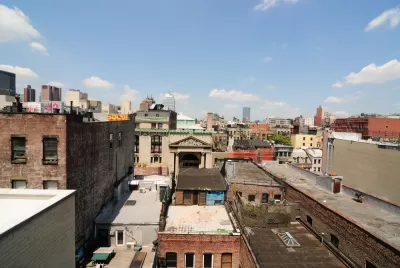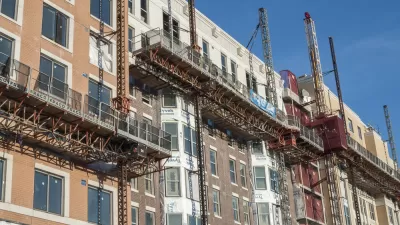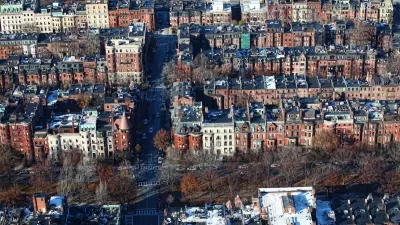Why should owners of buildings in illegally poor repair be able to buy more rentals? As Washington, D.C. found, it can be a difficult thing to prevent.

At first, the problem was just a broken light fixture in the kitchen. And the bathroom sink faucet that would pop off when turned. Amanda Hickman and her partner shrugged these off as the predictable aches and pains of renting an old apartment in San Francisco. But then California’s seasonal rain arrived. “We had a really heavy rainstorm and we had multiple buckets in the living room catching water that was falling in through the ceiling,” Hickman says. Repeated attempts to get the landlord to fix the ceiling went nowhere. Hickman knew it was time to go.
But something bigger than losing her deposit gnawed at Hickman as she made plans to relocate to a more hospitable place. “There were elderly tenants living in rent-controlled apartments in the building who had been there for many years,” Hickman recalls. “One of them, this old Russian guy, told me about how his sink had caved in and the landlord hadn’t fixed it, so he just didn’t have a sink. And I thought, ‘We can afford to move,’ but a lot of these other tenants couldn’t.”
Using her own experience and records from the city of San Francisco’s Department of Building Inspection website to document the landlord’s pattern of negligence, Hickman took her landlord to court. But pursuing accountability soon became very heavy lifting. As an individual taking on an errant property owner of several apartment buildings across the city, Hickman had to file a sheaf of claim forms in person and take entire days off of work to attend court hearings. When a judge ruled that Hickman’s landlord owed her money for the months when the apartment was unlivable, the landlord reacted by taking Hickman to small claims court on allegations that her dog had been too noisy. (“We were like, ‘OK... all of this is brand new to us!’” Hickman said.)
When all was said and done, Hickman moved out, got her deposit back, and was awarded a modest amount of damages. But her landlord still remained at large, ruffled but not reined in by this unusual instance of accountability.
The Slumlord Issue
Most of us know someone who’s been in Hickman’s position—living at the mercy of a landlord who racks up code violations as if they were parking tickets, allowing their property to fall into disrepair and dismissing their tenants’ requests for maintenance, even when safety is a concern. Property owners who display this pattern of behavior have long been called “slumlords” and as the cost of rent in American cities keeps skyrocketing mid-pandemic, partially due to a shortage of rental housing, cities and states are going after some of the most prolific offenders. Or at least trying to help some of their belabored tenants and spotlighting the slumlord issue.
In New Orleans, the city is busy relocating renters from the 336-unit Algiers complex, which fell into bankruptcy and has since festered with mold, insects, and raw sewage. Tenants from 27 rental units in Wilmington, Delaware, had to find other housing suddenly when the city condemned their landlord’s property due to deteriorated bricks and floor joists that the landlord had ignored. And in Tampa, Florida, Democratic gubernatorial candidate Nikki Fried lambasted the owners of Silver Oaks Apartments, where the tenants have endured plumbing issues and masses of rodents. “Florida renters are being taken advantage of,” Fried told reporters at a press conference outside the apartment complex. “Here at Silver Oaks Apartments ... management has flouted not just the federal rules but the rules of common decency and respect.”
The “federal rules” that Fried refers to are presumably the Section 8 housing quality standards outlined by the Department of Housing and Urban Development (HUD), which landlords must meet in order to be eligible to participate in the federal voucher program. (The renters at Silver Oaks Apartments are lower-income tenants, and the complex has received federal subsidies.) In theory, if a landlord’s property fails a Section 8 inspection conducted by their local housing authority on behalf of HUD, they can get cut off from the program. But when it comes to putting pressure on unsubsidized private landlords to make much-needed repairs to their properties, states and cities are often left to their own devices. This can leave tenants vulnerable to local legislatures, which are most influenced by real estate lobbying groups. (The largest of these groups, the National Association of Realtors, spent more than $84 million in 2020 in a bid to get the CDC’s nationwide eviction moratorium scrapped.) But limited federal involvement in the matter of housing conditions can also leave local governments with more leeway to come up with bold ideas for cracking down on bad landlords. For instance: what if instead of just forcing a landlord to make repairs, you could also cut them off from acquiring and renting more properties? ...
FULL STORY: Can We Prevent Slumlords from Buying More Buildings?

Alabama: Trump Terminates Settlements for Black Communities Harmed By Raw Sewage
Trump deemed the landmark civil rights agreement “illegal DEI and environmental justice policy.”

Planetizen Federal Action Tracker
A weekly monitor of how Trump’s orders and actions are impacting planners and planning in America.

The 120 Year Old Tiny Home Villages That Sheltered San Francisco’s Earthquake Refugees
More than a century ago, San Francisco mobilized to house thousands of residents displaced by the 1906 earthquake. Could their strategy offer a model for the present?

In Both Crashes and Crime, Public Transportation is Far Safer than Driving
Contrary to popular assumptions, public transportation has far lower crash and crime rates than automobile travel. For safer communities, improve and encourage transit travel.

Report: Zoning Reforms Should Complement Nashville’s Ambitious Transit Plan
Without reform, restrictive zoning codes will limit the impact of the city’s planned transit expansion and could exclude some of the residents who depend on transit the most.

Judge Orders Release of Frozen IRA, IIJA Funding
The decision is a victory for environmental groups who charged that freezing funds for critical infrastructure and disaster response programs caused “real and irreparable harm” to communities.
Urban Design for Planners 1: Software Tools
This six-course series explores essential urban design concepts using open source software and equips planners with the tools they need to participate fully in the urban design process.
Planning for Universal Design
Learn the tools for implementing Universal Design in planning regulations.
Clanton & Associates, Inc.
Jessamine County Fiscal Court
Institute for Housing and Urban Development Studies (IHS)
City of Grandview
Harvard GSD Executive Education
Toledo-Lucas County Plan Commissions
Salt Lake City
NYU Wagner Graduate School of Public Service





























